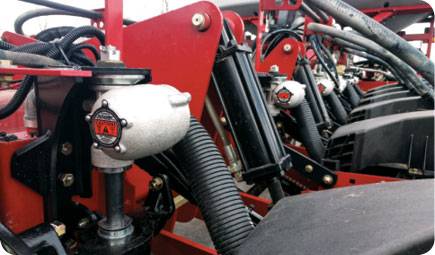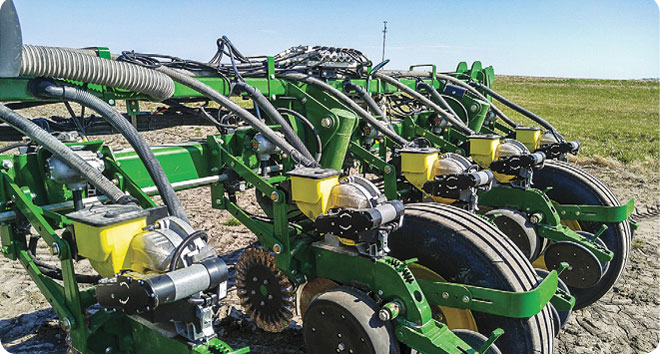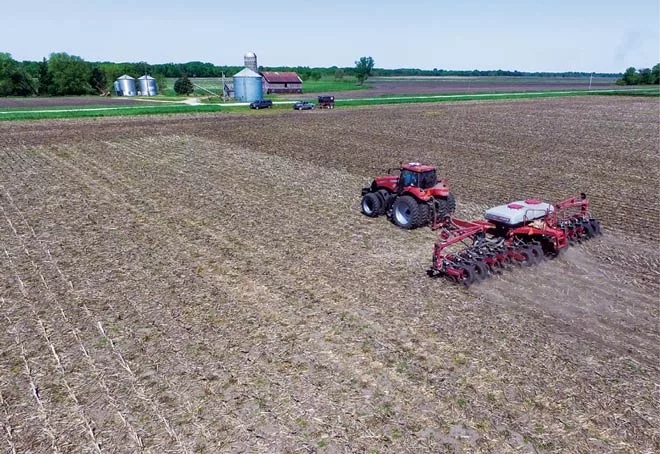Pictured Above: Affordable return on investment and the ability to offer alternative solutions to farm customers are two factors dealers point to as drivers of optimism and opportunity for increasing revenue in seeding and planting technologies.
Dealers are always looking to hone their entrepreneurial radars in on the next product or service that will strengthen their business bond with farm customers and provide a boost to the company’s bottom line.
While there is no shortage of opportunities on the precision farming side, identifying the most practical and profitable ones is essential. So what do dealers view as their most important pathway to precision farming equipment revenue in the next 5 years?
Seeding and planter control ranks atop the list of precision priorities for the majority of dealers, according to Precision Farming Dealer’s 2016 annual benchmark study. Some 60% of respondents identified planter and seeding control systems as having the most potential, and another 64% of dealers viewed variable-rate planting and fertilizing technology as a primary driver of revenue in the future.
So what is driving optimism and how are dealers looking to capitalize on the profit potential in these areas? Affordable return on investment and the ability to offer alternative solutions to farm customers are two factors dealers and suppliers point to as reasons for development, investment and adoption of planting technology.
Cooling Planter Sales
“As a company, we’re busier selling planter precision upgrades in the lower price corn market than we ever were back when farmers were getting $7 per bushel,” says Charlie Troxell, precision ag specialist for Precision Agri Service Inc. “Back then, everyone was trading in their planters for brand new ones rather than upgrading with aftermarket equipment. Right now, farmers are more likely to spend $40,000 on a planter upgrade than $140,000 on a whole new planter that won’t be much better than the one they have.”
Precision Agri Services Inc., based in Minster, Ohio, is a precision consulting company and dealer. Troxell says that many local farm equipment dealers are sitting on brand new planters because sales in that sector have ground to a halt with low corn prices. He also notes that although farmers are still spending conservatively in terms of how many planter upgrades they purchase, down force management has been particularly popular.

Even though pneumatic and hydraulic systems can both be fitted with automatic control, the two biggest differences are response time and control type, according to Alex Lundgren, product sales specialist with Ag Leader Technology.
“The market is heavily weighted toward planter control. Farmers might not be doing the whole gamut of precision planter technology, but many are making one upgrade at a time,” he says. “If we had to look at what we have sold most, I’d say it’s more toward down force systems.”
Troxell suspects this is because the immediate value of down force has been easier to prove to customers than other upgrades, such as electric drives or seed meters. In the down market, he feels that his customers are looking for the quickest payback on smaller purchases.
“Simply put, I can take an average meter and make it look good if I can keep all the seeds at depth with a good down force system,” he says. “On the other hand, I can take the best seed meter on the market and make it look average if I can’t keep the seeds in the ground at the same depth.”
Digging Into Down Force
To glean the optimum benefits from automatic down force systems, prospective users should look at several important factors to decide if the investment is a practical choice for their operation. To start, this means building an understanding of exactly what the technology is trying to accomplish.
One of the main variables down force technology attempts to control is seed depth. When a planter row unit applies less down force than needed, a seed may be planted too shallow, which will likely cause germination problems. If a row unit has too much down force, seeds may be planted too deep and have their development choked by compaction.
On a field with fairly uniform soil types and a consistent texture, a less sophisticated system can be set manually that will reliably plant seeds at the desired depth. But few fields have such perfect conditions.
Mark Hanna, Iowa State University extension ag engineer, points out that there are several grades of precision and adjustment methods when it comes to down force options.
“Farmers are more likely to spend $40,000 on a planter upgrade than $140,000 on a whole new planter that won’t be much better than the one they have…”
“The older method, which is still the stock option on some planters, is with pressure springs,” says Hanna. “The step up from there is a pneumatic system that uses an air bladder to regulate pressure on the gauge wheels. The newest version uses hydraulic fluid instead of air to make adjustments with positive displacement.
“Older systems are usually adjusted manually, but the newer automatic systems use a load cell sensor to measure and regulate contact force while the planter is pulled through the field.”
Even though pneumatic and hydraulic systems can both be fitted with automatic control, there are still differences between the two systems. Alex Lundgren, product sales specialist with Ag Leader Technology, says the two biggest differences are response time and control type.
“An airbag may take up to 20 seconds to respond to a reading, which can be too slow considering that the grower is probably driving 5-7 miles per hour across a field,” says Lundgren. “Hydraulic down force is able to respond much faster to overcome field conditions.
Dealer Takeaways
• Technology upgrades can be a more direct and economical sales path with customers vs. pitching a completely new planter.
• Proving ROI with real-world examples and evidence can be the linchpin of selling a suite of planting technology systems.
• Flexibility with scope of available planter products and services can broaden your customer base to include large and small operations.
“There is also true automatic control. There’s no need to set a parameter, which would be an ever-changing number. Our hydraulic down force adjusts for you. It’s also individually row controlled, while air bag systems are typically only 1 or 2 channels.”
Return on Investment
Although many manufacturers offer estimates for potential yield increases an automatic down force system can offer, the benefits of the technology are highly dependent on a few key variables.
Beck’s Practical Farm Research completed an independent study using an Ag Leader hydraulic down force system and compared it to airbags, when planting corn. The test put manually set airbags at 125 pounds of pressure against Ag Leader’s automatically controlled system, and the results showed the hydraulic down force system yielded 10.3 bushel per acre more, Lundgren says.
Precision Planting says its DeltaForce system can deliver similar outcomes. The results of a 5-year study conducted by a third party found a yield advantage of 11 bushels an acre or more in corn.
However, engineers and farmers caution that these benchmarks are probably not the best figures to build an expectation around. The manufacturers themselves are quick to note that farmers will probably see the technology at its most beneficial only if they’ve properly deduced the need for it on their farms.
“There are a lot of great products on the market, but they aren’t a 100% fit for everyone,” says Ben Schlipf, Precision Planting’s engineering lead. “A farmer can see huge returns from an automatic system, but they have to gauge how sensitive their environment is to proper down force.
“They first have to try to understand what the potential damage yield-wise is by not having appropriate down force. That’s really the only way to be sure of what they stand to gain by having accurate and uniform down pressure and whether or not the investment is worthwhile.”
Hanna notes that soil types, the tillage environment and overall acreage are usually the best predictors of how fast the upgrade will pay for itself.
Farmer Feedback: Taking the Pressure off Planting
In a few important ways, William Cran, who farms 1,500 acres of corn and soybeans with his father Robert, represents the ideal demographic for automatic planter down force.
The technology is a good fit for Cran’s operation just outside Bradgate, Iowa, because his acreage is large enough to exploit economy of scale. He has both no-tilled and conventionally tilled fields and much of his ground is comprised of highly variable river bottom soils.
In early 2016, Cran upgraded from the manually adjusted pneumatic down force system on his 16-row Case 1250 planter to Ag Leader’s automatic hydraulic down force system. Although he’s only used the new setup for one planting season, the benefits have already been obvious.
Partly due to the inconvenience of adjusting his old system in the field, Cran admits that he would usually only alter his down pressure two to three times per season. He’d usually leave it set around 100-120 pounds of pressure.
But while planting earlier this year with the new system, he noticed the sensors on his down force system would often call for as high as 250-300 pounds of pressure at various points in the field to maintain seed depth.
“We could tell early on that our payback was going to come a bit quicker from these areas,” Cran says. “I saw everything come out of the ground at the exact same height. That was especially surprising to see on the farm drives where all the grain carts and tractors come and go from the field and compact the soil. In past years, it would be assumed that those spots, and others like it, would just not grow much. Plants would come up late or not at all.”
Cran admits that trial and error was part of the process to evaluate how much yield he was losing by not accurately calculating down pressure. Without knowing exactly how much yield the technology would add to his operation, he had to appraise his farm and the need for the upgrade more closely before making it.
“Eventually, we felt comfortable making the investment because we have such variable soil types and compaction,” says Cran.
He feels that the learning curve with the technology isn’t very steep and adds that spending some time to familiarize himself with the system, and remaining conscious of the planting conditions, were enough to ensure proper use.
“For our system there are 5 settings from low to max,” says Cran. “We did 90% of our acres on the medium setting and tried running with a bit less down force on some of the conventionally tilled fields, where there just wasn’t as much needed.
“From a user interface standpoint, once the system is installed it’s really easy to use. We spent about 10-15 minutes learning how it worked and how to run the display and haven’t had an issue.”
“If soils are reasonably uniform, the payback can be slower. You can even get by with adjusting your existing system manually for those conditions.” says Hanna. “When you get into heavily variable soils where moisture level or texture vary significantly throughout the field, you’ll need to adjust more regularly and an automatic system is a better way to do that.”
By maintaining seed depth across the field regardless of soil conditions, a farmer can be assured that they’re reaching more yield potential. For fields where this is already possible with stock planter down force, the difference a hydraulic system will make is negligible, experts say.
Additionally, if a farm is smaller, regardless of how variable its soil types are, the payback rate will be slower. Rodney Arthur, planter automation product manager with Dawn Equipment, which manufacturers the RFX hydraulic down force system, highlights the importance of scale.
“If you’re farming 250 acres of corn with an 8 row planter, investing in a good row cleaner or better closing wheels would probably be much better than an automatic down force system,” says Arthur. “But, if you’re farming more like 2,500 or 5,000 acres with a 24 row planter, you might actually be costing yourself enormous amounts of money by not having such a system.”
Capitalizing on Upgrades
The Precision Farming Dealer benchmark study indicated that dealers are sensing the market demand for precision equipment in the planting and seeding control category. But what strategies are called for to convert that demand into sales?
Ken Larsen, precision specialist at Vetter Equipment, feels that customer education plays a large role in spurring sales in the sector. Vetter Equipment, an 11-store Case IH dealership group in Iowa, holds clinics regularly to that end.
“I can take an average meter and make it look good if I can keep all the seeds at depth with a good down force system…”
“We have customer clinics in the spring and the fall,” Larsen says. “We focus on trying to show customers what’s available for planter control and how to run it. It’s been important to do hands-on demonstrations in the spring, so farmers without any experience with the equipment get a better understanding of it.”
Another sector for growth that’s attached to the planter control systems are precision service packages aimed at calibrating, adjusting and troubleshooting the systems. Troxell and Larsen both agree though, that designing equitable precision service packages has been tricky.
“We’ve really been pushing our service plans this year, more than we have in the past and we’re getting a lot of interest,” says Larsen. “But we still haven’t hit on that one-size-fits-all solution. We have to do a lot of customization in terms of phone support and labor hours per package, so we can figure out what works best for our customers and us at the same time.”
Troxell has seen potential in financing options when it comes to increasing sales in the planting and seeding control market. While some farmers may be unwilling to make upgrades with cash, a sale may still be possible through a more creative approach.

Dealers are seeing potential in financing options when it comes to increasing sales in the planting and seeding control market. While some farmers may be unwilling to make upgrades with cash, a sale may still be possible through a more creative approach.
Photo Courtesy of Ag Leader
“Precision Planting allows their dealer network to work through a big lending institution in the ag world, and we’ve been able to offer really competitive rates through it,” he says. “With a lot of the precision upgrades, if we’re able to show a return on the investment in 3-5 years, it can make financing a $40,000-$100,000 upgrade much easier to pay for.”
Advantages of this approach include an alternative to the other lending institutions that farm customers may be working with, and since the lender Troxell works with is already ag specific, proving the value of upgrades isn’t as hard as it would be with a more traditional lender. “Convincing the lender is already done,” he says. “It just comes down to convincing the farmer.”
Troxell has had the most success selling planter upgrades by penciling out the return with his customers using the most conservative metrics available. He takes into account the OEM’s estimated yield advantage for the precision equipment, but also tries to show the farmer studies done by impartial parties. “I look at the estimated yield advantages that some of the seed companies like Becks and Pioneer have put together for equipment like down force systems,” he says.
By stacking the estimated yield advantage against projected crop prices, Troxell tries to show his customers what they can expect from a given planter upgrade in terms of return.
“We try to be as conservative as possible,” he says. “Some customers use their actual contracted prices. For instance, if a farmer has his corn already contracted at $3.20 per bushel and Precision Planting says he’ll see a 9 bushel advantage with DeltaForce over what he’s currently using, I’ll compare that to the other studies and just cut it down to a 4-5 bushel advantage.
“Then we’ll run that through how many acres the customer farms. A lot of farmers can pay back a pretty significant upgrade fairly quickly even at those conservative yield increases. We’ve been able to sell a lot of systems this way.”




![[Technology Corner] Autonomy & Robotics Take Center Stage](https://www.precisionfarmingdealer.com/ext/resources/2026/01/12/Autonomy--Robotics-Take-Center-Stage.webp?height=290&t=1768253759&width=400)


